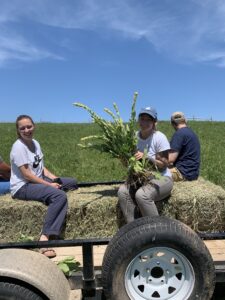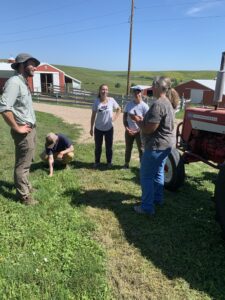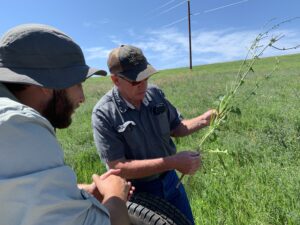Final report for FNC19-1187
Project Information
In 2001, the Pavels purchased Butte Vista Farm, a conventional 200-acre farm located in Lawrence County, South Dakota, on the northern foothills of the Black Hills. The primary crop is grass/alfalfa hay, which is sold and/or used for the Pavels’ livestock, including a herd of crossbred Boer goats. All of the goats were used for this project. Additionally, 15 - 20 Angus cattle were grazed on the farm’s mixed-grass pastures in the spring, summer, and fall on a per-head, per-day basis. Cross-fencing and watering systems allowed for pasture rotation to sustain grass conditions and prevent overgrazing.
The Pavels have participated in a number of SARE projects in the past. In 2017, Mr. Pavel assisted an additional research project, funded through the South Dakota Cooperative Extension Service and the United States Department of the Interior, Bureau of Land Management. That project's goal was to evaluate the effectiveness of intensively grazing sheep to control Dalmatian Toadflax. Mr. Pavel monitored the condition of a 25-head flock of sheep and the amount and type of forage they consumed, set up test plots, and documented results. Much of what was learned from that project was applied to this chicory project.
In our semi-arid environment, chicory can quickly spread into adjoining pastures, crop and hay land, choking out desirable plants, creating unhealthy ground cover, and plummeting forage and crop production.
Livestock generally avoid the maturing plant. Marketing of forage products from an infested field is prohibited.
Chicory has historically existed where our farm is located, thus creating a vast accumulation of chicory seeds in our soils. Post-emergence herbicides have been typically not as effective as pre-emergence chemicals. Failed control methods generally propagate chicory further. Chicory has become prolific in many previously weed-free areas well beyond our farm’s location. Consequently, in 2019 Lawrence County listed chicory on the county’s noxious weed list.
While we have typically utilized conventional practices on Butte Vista Farm, our project was designed to demonstrate Integrated Weed Management’s (IWM) effectiveness in controlling chicory in side-by-side conventional and organic methodology operational processes. By blending and incorporating the five IWM strategies (preventive, cultural, mechanical, biological, and chemical) into real-life, doable applications, an effective, ecologically-sound, financially-viable solution that is suitable for nearly any agricultural operation could be demonstrated. Long-term operational sustainability through enhanced quality and production of the land, resource stewardship, and improved bottom line for the family farm then becomes more plausible.
- Apply and evaluate Integrated Weed Management practices to control chicory via methods that are readily-achievable by average producers, both short- and long-term, in accordance with conventional and organic parameters. Specifically:
a. Test weed control results on intensively-grazed and non-grazed test plots using varied rates of pre-emergence herbicides, post-emergence herbicides, and no chemical, and
b. Evaluate mowing at different intervals. - Be mindful of not marketing infested hay.
- Share findings through field days, a website, social media, a newsletter, and an activity blog.
Cooperators
- (Researcher)
Research
The spreading of chicory via seeds can be wide-ranging; thus, the ultimate goal is to control seed production. Chicory also propagates from existing plants. And while its spread is more confined when regenerating from older plants, as the plant population increases, the potential for more seeds to be produced grows exponentially if the plant numbers are not controlled. In this research, Butte Vista Farm utilized the five Integrated Weed Management (IWM) principles (preventative, cultural, mechanical, chemical, and biological) to measure and evaluate their effectiveness in controlling chicory. Specified practices on Butte Vista Farm were performed in 2019, then repeated in 2020, with modifications of activity in 2020 dictated by evaluation of the 2019 data.
Grazing was monitored to assure less than 50% of the forage was removed. Over-grazing weakens desirable plants, especially in dry conditions, affording chicory an opportunity to literally take root. Once grazing tests were completed, animals were placed in a confined area for five days to assure their digestive system was clear of viable weed seeds, especially if the potential existed for viable weed seeds to be present in the animals’ manure. Because seeds may be harvested during haying season, infested forage was not marketed.
Pre- and post-emergence chemicals were tested, at varied rates, on rotational grazed and non-grazed plots. Grazed areas without chemical treatments were compared to chemically treated plots. The plots were small (less than one-acre each) to realize a measurable difference. Plots were situated within infested areas of the farm and, if necessary, enclosed by solar-powered electric fences. Drawing from our experience gained from the flock of sheep used in the Bureau of Land Management project we assisted with, it was considered that the goats may have needed to acquire a taste for chicory. Hence, one small plot was set aside as a “training plot.” As is documented in the research results, such training was not necessary. Chemical-only trials were performed on plots within a hay field. Areas adjacent to the test plots were chemically and mechanically treated to avoid any cross-contamination of undesirable plants from the surrounding areas into the test plots.
As has been observed first-hand in the fields and pastures of Butte Vista Farm, chicory can quickly reduce the number of desirable plant species in an affected area. Ground cover and soil health conditions may be compromised. Thus, conditions were closely monitored to evaluate the impact of an infestation of chicory. Soil health tests were conducted to fully ascertain the impact of allowing chicory to grow in an unchecked manner. Soil health enhancing practices (cover crops, application of manure, no-till practices) were tested to sustain or improve soil health as needed.
Our two-year Farmer/Rancher project titled “The evaluation of Integrated Weed Management practices to control chicory infestation in the pastures and hay ground of conventional and organic agricultural operations” is complete. The process was wide-ranging and multifaceted, and it involved conducting multiple research projects at the same time. A great amount of information was gathered, studied, and evaluated. The length of this final report is probably an indication of the volume of data collected. We hope we succeeded in doing more than merely scratching the surface on the five IWM principles and that we were able to delve a little deeper in the pros and cons of each.
Upon applying for our grant, we outlined three objectives to accomplish during the project:
- Apply and evaluate Integrated Weed Management (IWM) practices to control chicory via methods that are readily-achievable by average producers, both short- and long-term, in accordance with conventional and organic parameters. Specifically:
- Test weed control results on intensively-grazed and non-grazed test plots using varied rates of pre-emergence herbicides, post-emergence herbicides, and no chemical, and
- Evaluate mowing at different intervals necessary to control the propagation of chicory seed production.
- Be mindful of not marketing infested hay.
- Share findings through field days promoted by professional production agriculture and conservation agencies, a website, social media, a newsletter, and an activity blog.
Once the project got underway, two other objectives were added:
- With the assistance of staff from the local office of the USDA Natural Resource Conservation Service, evaluate soil health conditions on weed-infested and weed-free soils, and
- Assess no-till/minimum till seedings of cover crops onto fallowed crop land to control new weed growth.
As mentioned, a great deal of information has been collected over the past two years and, with the exception of the planting of cover crops, the objectives were met. The preliminary results have been documented in the 2019 and 2020 blog posts posted on our farm’s website (www.buttevistafarm.com).
HOW WOULD WE KNOW IF OUR WEED CONTROL TECHNIQUES WERE SUCCESSFUL?
Although we learned a great deal and have much to report, we would be negligent if we failed to mention that, early on, we struggled with what, in the end, would define a successful accomplishment of our goals and objectives. Initially, we felt certain about some things.
We sincerely thought we had our plan figured out. It soon became quite apparent that, as amateurs, we needed to learn more of the research process itself. We had some concept of “research,” but something that is quite likely obvious to university staff was not obvious to us.
To apply for the grant, we spent hours upon hours reading, researching, writing, and developing our project. We knew that with any research (whether completed by amateur or professional, science or academia staff), the research techniques must be reliable and valid and there must be a standard or criteria with which to measure success. To be credible, the processes needed to be done without bias and not tainted with pre-conceived notions. In the case of this SARE project, we knew the results should provide other producers with information with which they could feel comfortable and confident would enhance their operations.
Although we knew we wanted to control the chicory problem (as written several times in our objectives), we realized after implementing our research processes that the term “control” means many things to different people. Control can be a stopgap measure designed only to temporarily keep the problem from spreading to another field or neighboring area. It can be done with no concern of reducing the problem and being content that the weedy field won’t ever be profitable. Control can also mean to reduce the problem in the targeted field or pasture by better managing the weed infestation there and suppressing it from spreading further—with a strategy to eventually improve the infested field. Finally, control can be to ultimately eliminate the infestation so it is no longer an issue and to focus on improving production and health of the field and overall agricultural operation.
Early in our project, we had to be honest with ourselves and admit that we didn’t really know what we intended. Why would anyone consider our suggestions if we couldn’t even decide ourselves if we were successful?
DEFINING THE FULL SCOPE OF “SUSTAINABILITY”
Fortunately, to submit an application for this Farmer/Rancher grant, we were required to describe how our project “will make a meaningful contribution to sustainable agriculture.” Along with not realizing what “control” meant, we also didn’t yet appreciate the depth of that question. We were forced to resolve that matter to a much fuller degree before earnestly moving forward.
“Sustainability” is an often-heard term. However, if a person were to read articles on many mainstream or social media sites regarding sustainable agriculture, it seems as though the decisive factor whether an ag producer is perceived as a “good” farmer/rancher or a “bad” one depends only upon whether or not their practices “sustained” the environment. Despite being in production ag for nearly three decades, we believed much the same until we gave the issue more thought.
This project forced us to take a thorough examination of what we did short- and long-term on our farm. We soon concluded that, in a production agriculture setting, the environmentally-focused explanation of “sustainability” was not all-encompassing. We deduced that if anyone were going to find our work, efforts, and recommendations worthwhile, our goal had to be to find solutions that were real, used common sense, were practical, and kept us in business for years to come. Our results could not deplete natural, human, or financial resources; the methods needed to provide long-term solutions. What producer would appreciate our solutions if they were only practical for a short period of time or merely masked the symptom of the problem? Our recommendations had to establish what the “cost” would be (monetary, time, physical labor, environmental impact, etc.). Could we “keep them up”? In other words, could our solutions be “sustained”?
To get an appreciation of what that meant, we went to www.sare.org/resources/what-is-sustainable-agriculture/. This time, we gave the topic more than a cursory view. There we found four central pillars that define what sustainable agriculture is all about.
According to SARE (2021), the four central pillars of sustainable agriculture are:
- Productivity: Grow enough food and fiber to meet humanity’s needs
- Stewardship: Enhance the quality of the land, water and air; and make the most efficient use of nonrenewable resources
- Profitability: Maintain the economic viability of farms and ranches
- Quality of Life: Promote the resilience and well-being of producers, their families and society as a whole
In our September 2019 blog post “The Question of Sustainability,” we listed three of these pillars. The fourth, “Productivity,” is an important addition we want to emphasize as well.
The Western SARE website (https://western.sare.org/about/What-is-Sustainable-Agriculture/) also shares this viewpoint from Dr. John E. Ikerd, Extension Professor at the University of Missouri: “A sustainable agriculture must be economically viable, socially responsible and ecologically sound. The economic, social and ecological are interrelated, and all are essential to sustainability. An agriculture that uses up or degrades its natural resource base, or pollutes the natural environment, eventually will lose its ability to produce. It's not sustainable. An agriculture that isn't profitable, at least over time, will not allow its farmers to stay in business. It's not sustainable. An agriculture that fails to meet the needs of society, as producers and citizens as well as consumers, will not be sustained by society. It's not sustainable. A sustainable agriculture must be all three—ecologically sound, economically viable and socially responsible. And the three must be in harmony.”
Using these criteria, we were more able to clarify our definition of “control.” We knew what our standards for “success” would be.
SUSTAINABLE VERSUS REGENERATIVE AGRICULTURE
Another term often used in publications and articles is “regenerative agriculture.” The entire principle of this concept is another topic for another time but, in the way of staying up–to–date on emerging practices, producers should probably take time to review this movement as well. A quick glance at information on the web will reveal that it has some common ground with sustainability but it takes production agriculture to another level.
Some regenerative proponents profess a broad organic, chemical-free, global, climate-change emphasis. However, from the standpoint of a long-term, successful agriculture producer, the difference between sustainability and regenerative ag is actually quite straight forward—with one actually being an expansion of the other. Sustainability may be viewed as successfully “maintaining” the full gamut of an operation’s resources so the farm or ranch may exist well into the future, or not depleting but preserving the operation’s natural, financial, and human resources. On the other hand, regenerative agriculture not only maintains the desired status quo but improves the quality of the operation’s natural resources and, while doing so, evermore sustains the financial and human assets of the farm or ranch.
The regenerative ideology isn’t all that new. Much like sustainable agriculture, many producers have probably been “regenerative” in nature for some time. They just didn’t know there was a label associated with it. Perhaps the label is just receiving more attention. If we are seeing it mentioned more in our agricultural publications, we can be assured that the food consumers are becoming aware of it, too. No one will deny that the consumer has influence on how agricultural producers do things. It would behoove us to stay in-tune with the movement and even consider incorporating those ideas and discussions into our operations.
WHY SPEND SO MUCH TIME ON THESE TOPICS IN OUR REPORT?
We want to emphasize to readers that, when considering planning future projects, it’s difficult to develop a map to get to where one WANTS TO GO if it isn’t known where one WANTS TO BE. Realizing the true meaning of sustainable agriculture (being well beyond the preservation of our soils and water), in itself, made our two-years of working through our project as valuable to us as the results of testing and researching the IWM practices. To be sustainable (and, in the future, more regenerative), we determined that “controlling” chicory did not merely mean to put a quick Band-Aid on the problem but to suppress, reduce, and, ultimately, eliminate the weed. This goal became even clearer as we learned the growth habits and plant physiology of chicory.
Once we determined that definition of “control,” we had a guide, a test, a measuring stick so to speak to evaluate each of the five IWM methods we applied (biological/grazing, mechanical/mowing/hand-pulling, cultural/cover crop/soil health, chemical, and preventative) and we could determine whether what we were doing was worthwhile and whether we had anything worthy to share with others.
Among the recommendations we will make to anyone reading our project’s results, we will add another: Before you consider a change, or simply want to assess what you are doing on your farm or ranch, consider taking the time to evaluate how whatever you are about to do measures up to the sustainability criteria mentioned above. As noted previously, we covered this topic in detail in our September 30, 2019 blog post “The Question of Sustainability.” In that post, we reviewed the preliminary results, up to that time, of each of our applications of the five IWM principles and graded them according to what seemed to be workable for the long-term and what offered only a temporary “cover-up” of the real problem.
Those results are still valid, but we can now expand further on the results, providing an even more certain conclusion. Now that we have two years of results to consider, we can fully evaluate in this final report each of the IWM principles we used and be confident that, if a producer considers our recommendations, they may also realize a positive, sustainable, long-term solution to not simply control but to reduce or eliminate an invasive chicory problem.
Educational & Outreach Activities
Participation Summary:
In 2019, we conducted several different methods of outreach to inform producers and professionals of the goals of our project. We are of the belief that in order to realize the full benefit of a research project, the information must be shared with those who can use it.
First, with the assistance of a local small business that offers services in social media management (Little Leaf Copy Editing), we established a monthly electronic newsletter and blog that was linked to our farm’s website (www.buttevistafarm.com) and Facebook page. Visitors to the website’s homepage could readily identify how to access the information, along with an indication that the project is funded through SARE and that the research is being done in cooperation with South Dakota State University. Also on the site is an explanation of the principles of IWM (Integrated Weed Management), which serves as the basis for the on-farm research project being conducted. Interested individuals could sign up for a newsletter that was regularly emailed to them at the same time the blog posts were posted on the farm’s website. These efforts continued in 2020 with an effort to reach more professional and producer groups.
We live in an area that has professionals working for the US Forest Service; US Fish and Wildlife Service; US Department of the Interior (Bureau of Land Management); South Dakota Game, Fish and Parks, local and state weed commissions, and others who directly deal with invasive weeds and pests. Through routine conversations with some of these individuals, it came to our attention that they were dealing with an encroachment of chicory. While we knew that chicory had become invasive in our immediate area, and that it was spreading to agricultural lands in our region, we were a bit astounded to learn how much it had spread to the nearby public lands and forest. The agency personnel charged with controlling the weeds were actively searching for trusted data to assist them. We received affirmation that, as we have found in dealing with chicory for some time on our farm, published information about controlling chicory is limited. Many of these professionals were being put in the position of having to learn what control methods are successful and sustainable. They now have direct knowledge of our research efforts.
Of particular interest to them was that we had South Dakota State University doing university-level trials on a number of types of herbicides selected to target the control of chicory. We were and continue working with local experts with the Natural Resource and Conservation Service on conservation efforts on our farm that, although are more broad-based than our project, tie directly into our Integrated Weed Management program. It must be said that because we at Butte Vista Farm are actively working with SARE, South Dakota State University, and our contacts with the Natural Resource Conservation Service (NRCS), our project has earned credibility and agency professionals are eager to learn what we discover. Obviously, in 2020, we did not take that for granted and we strived to continue our efforts to make more people aware of what our SARE project is all about. The social media platform that has been established for the project will continue to be key in those efforts.
As with the industry professionals, getting information to producers is equally important. Organizations that serve the farmers and ranchers in the area (such as the South Dakota Grasslands Coalition, the local conservation districts, Cooperative Extension, etc.) offer an avenue to contact people who could benefit from the results of our project. We have and now continue to participate in the events and tours sponsored by these organizations, and that has afforded us the chance to have an informal conversation with people (ag producers and professionals) we meet about what we are doing with our farm-based research. The year 2020 presented new challenges as will be mentioned in a moment.
In 2019, we were invited to speak to local and state professional groups at conferences or meetings being held in our area. Through our contact with NRCS, we had the chance to give a brief review of our research to the South Dakota Ag and Rural Leadership group when they met in the Black Hills in June of 2019. We were able to talk about our research goals with about 20 people (agriculture producers and ag professionals from across the state). Mr. Paul Johnson, who is the Weed and Science Coordinator with South Dakota State University Cooperative Extension (and the participating expert advisor for our project, conducting the herbicide trials on our farm) is an ad hoc member of the South Dakota Weed and Pest Commission, whose purpose is to develop programs for the prevention, suppression, control, and eradication of weeds and pests in South Dakota. He arranged for us to present our program to the 10 members of the Commission at their meeting in Rapid City in September of 2019. Also in attendance in the audience were several county weed and pest supervisors. This allowed us to share details of our project with nearly 30 weed and pest professionals. The following day, we hosted a tour of the project for a small group of the county weed and pest supervisors, which gave us a one-on-one opportunity to explain what IWM is doing for us. Further, because chicory has recently been listed as a local noxious weed in our county (Lawrence County), we have been in regular contact with our county weed and pest board. In 2019, we made two presentations to the board as to how the control efforts are evolving. The Lawrence County Weed and Pest Supervisor has personally toured our farm to discuss the chicory issue. As noted above, we had hoped to continue to participate in such meetings, seminars, and presentations in 2020 as the opportunities present themselves. The COVID-19 pandemic changed many of those plans.
We discovered that merely by word-of-mouth, others learned about our efforts. In April of 2019, we were contacted by a reporter from a local newspaper. An article titled “Whitewood farm a test site for controlling spread of chicory” was published in the Black Hills Pioneer newspaper and posted on the paper’s online e-edition on May 1, 2019.
That article and the research information on our website then garnered the attention of our county’s conservation district personnel. As a result, on July 10, 2019, we were notified of our being named the recipient of the 2019 Lawrence County Conservation District Conservation Citizenship Award. The award was presented to us at the local Butte-Lawrence County Fair on August 1, 2019.
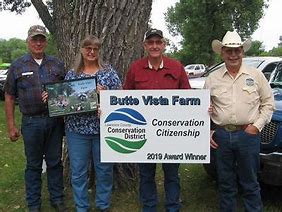
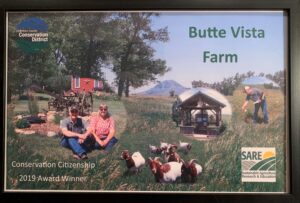
Then, because of our connection with the Lawrence County Conservation District, we had the unique opportunity to host a tour for the executive director and a number of biology interns from the Phoenix Conservancy, a non-profit, State of Washington-based conservation organization whose mission (according to their website www.phoenixconservancy.org) is “[t]o restore endangered ecosystems globally for the communities that depend on them and the conservation of biodiversity.” This was an enjoyable opportunity to share ideas. We undoubtedly learned more from them than they learned from us.
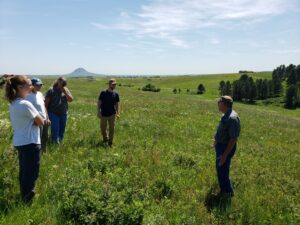
We also had the opportunity to directly speak with numerous other individuals who visited the farm, some for the specific purpose of learning of our project and others who merely stopped by to visit. We never missed an opportunity to discuss what we are doing through our research. We had also visited with our neighboring producers about our efforts even before the project began. Consequently, many of them have kept in contact with us as well. Through these informal efforts, we had been able to discuss IWM options with a number of people to control weeds on their properties.
There were others we contacted for advice and thoughts on specific issues that we were struggling with, such as controlling chicory in pastures and hayfields using organically accepted methods. The organic IWM methods we were trying did temporarily control the chicory, but the means of doing so seemed far from sustainable. One such organization we contacted was the Midwest Organic and Sustainable Education Service (MOSES), a nonprofit organization located in Spring Valley, WI. This led us to be put in contact with an organic farmer in Minnesota to discuss and share ideas. In an interesting chain of events, the farmer offered to do some checking with his contacts and get some ideas since most of his efforts involved farming (tillage) of the fields to control the weeds, which was not an ideal option for us considering our land and climate conditions. One of his contacts turned out to be Mr. Paul Johnson (the same person who is our expert advisor). Within moments of his discussion with Mr. Johnson, it was revealed that Paul was very familiar with the issue we talking about because he was directly involved in the project through the herbicide trials. So, the conversation came full circle. Unfortunately, it emphasized the point that little has actually been learned or published on what we were researching in our project. As the Minnesota farmer explained to me, our project appears to be on the leading edge of developing solutions.
All in all, our outreach efforts granted us numerous opportunities to discuss our project. Those efforts were to continue in 2020 with emphasis on those areas we recognized as needing additional attention. However, things changed.
Due to the COVID-19 restrictions, very little in-person interaction with professionals or producers took place in 2020. We had plans to conduct a one-day farm tour in the fall of 2020 for ag producers, conservation professionals, and agency experts to showcase our results, even to include a corporate-sponsored lunch. Obviously, that did not happen.
Therefore, the main opportunity to share research information took place when hay customers stopped to get hay products and the research data was shared as part of one-on-one discussions. Also, we continued to publish the newsletter and blog on our social media accounts (email, Facebook, and farm website). Finally, with the conclusion of the project, a fact/data sheet has been developed that can be mailed to interested parties and will be shared with the local offices of the USDA NRCS, US Department of Interior Bureau of Land Management, US Forest Service, South Dakota State University Cooperative Extension, the local Invasive Species Management Department, and other interested professionals. A copy of that fact sheet is included here (Fact Sheet).
Learning Outcomes
We will specifically review the results of our efforts and recommendations for each of the five Integrated Weed Management principles (biological, mechanical, cultural, chemical, and preventative) below. Additional information on the points made here can be found by visiting our website (www.buttevistafarm.com) and reading the individual blog posts.
CONVENTIONAL VERSUS ORGANIC PROCESSES
Our project was focused on researching and evaluating methods that could be recommended to either conventional or organic producers. Clearly, in the end, we gathered far more options for conventional operators than for organic farms/ranches, the reasons of which will be explained below.
Across the board, one lesson common to each of the five elements of IWM, as applied to organic methods and then evaluated against the cornerstones of sustainability, is that in our semi-arid climate, environment, and nature of agriculture production, organic processes presented far greater challenges and noticeably fewer long-lasting successes. We found that when attempting to apply IWM methods to organic practices to try to develop some legitimate recommendations, many plans, as noble and visionary as they may have been, failed.
A pitfall often experienced by those wanting to try new ideas is that something innovative that has shown promise to addressing a problem in some part of the country or world may not work everywhere. Individuals may want to bring those ideas to their operation, anticipating great results, only to find that what works in an area receiving 30-35 inches of moisture a year is nearly impractical in their climate of 20 inches or less of annual moisture. Attempting to solve an issue with impractical solutions can quickly replace one problem with another. For example, many organic methods successfully used in row-crop production areas located 200 miles or more east of us are almost unworkable in our fragile, rangeland eco-systems. Realizing that too late can actually have detrimental effects on an operation’s sustainability. The problem can become exacerbated to the point that a major change of methods is necessary to avoid nearly-overwhelming consequences.
We are aware of organic beef and hay producers in the western United States, in areas with similar growing conditions to ours. However, we are not familiar with how they have successfully accomplished and maintained productive organic fields and pastures on a long-term basis. Certainly, grassland experts clearly suggest that judiciously monitored, rotational grazing practices that retain ground cover and soil health conditions will keep weed problems at bay. Unfortunately, we have found little research available to demonstrate how to effectively and organically rejuvenate a pasture or dry-land hayfield once a weed infestation becomes unmanageable.
While it may appear as though we are biased against organic agriculture, we are merely trying to display full-disclosure of the facts of what worked and what bears caution. We are not stating that organic IWM methods are ineffective in all cases and for all undesirable plants and weed species. We are specifically studying the impact of IWM methods against the growth habits and invasive nature of chicory.
If there is one firm lesson we can share with organic producers in climate and production areas similar to ours, it is that it is essential to take measures to get a chicory infestation under control (likely with conventional or non-organic methods) BEFORE seeking organic certification. In that way, a minor infestation may be manageable for a time, at least initially, without having to resort to conventional methods. On our farm, we saw the chicory problem grow over time, and while we were able to keep the infestation at bay for a while without resorting to chemicals, the chicory eventually propagated to the point where we actually lost an entire field to production and risked losing more fields. We then had to take other action.
In our case, if we would have organically certified that field, we would have had to take the field out of organic status, use conventional methods to regain control of the chicory, and then recertify the field. Upon checking with other organic producers, even those in row-crop agriculture areas where they can use tillage-based farming methods, we learned that, from time to time, they also have to resort to that method.
The bottom line is that no matter what practices a producer believes in, they must be willing to adapt to problems if they are to assure their operation is sustainable, even if it goes against their long-held, passionate beliefs, whether those be conventional or organic. With all that said, these are the results of our research on the five IWM methods.
BIOLOGICAL/GRAZING
As noted in earlier reports, grazing fields and pastures without other IWM practices, whether using cattle or goats individually or in a co-species grazing arrangement, can have some effect on controlling chicory—for a time. However, if the chicory plants are young and in the pre-flowering stage, the livestock will likely avoid eating the plants because of the naturally bitter taste of the leaves. Grazing may not show a measurable impact until after the plants bolt a little later in the growing season, at which time the grasses and other forage varieties are not as attractive as they were earlier. Goats typically will then show some interest in consuming the flowers and will forage on the stems. Goats also like to graze plants that are chest-high. So, again, they generally eat less forage low to the ground. Fortunately, from our experience, the goats seemed to like the taste of the flowers and so they consumed them regardless of how high off the ground the flowers were.
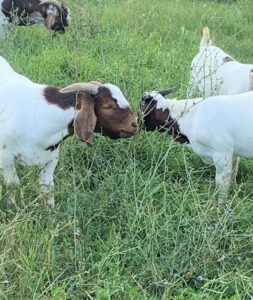
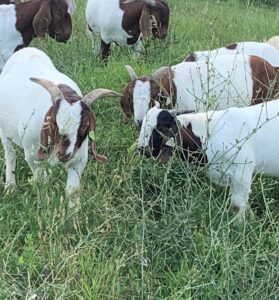
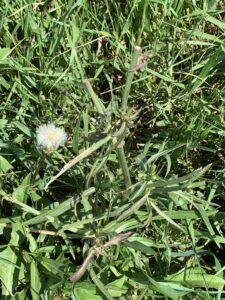
However, over this two-year research period, as well as several years in the past, we have found that goats are unable to eliminate the chicory plants. This is because chicory reproduces in two ways: from seed and by new growth from existing plants. We have seen that if, for whatever reason, the animals are removed from grazing the problem areas, the chicory returns, often more prolific than before grazing. This fact, as we have observed for years, was strongly supported by our two-year project.
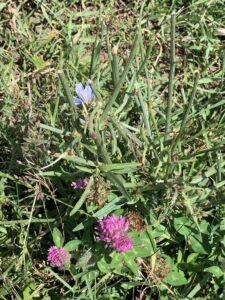
As we conducted research to prepare the proposal for this project, we learned that if the objective is to actually increase the population of the chicory plant (as in cultivated crops of chicory), the plant should, in fact, be mowed or grazed. A study by the University of Kentucky concluded that “[m]owing or grazing at proper intervals will help stimulate dense chicory regrowth…” (AGR-190: Chicory: An Alternative Livestock Forage (uky.edu)). The Kentucky study also reported that, for optimum yield, the chicory plant should not be grazed excessively: “[C]are must be taken to prevent overgrazing. A stubble height of 1.5 to 2 inches must remain after grazing for optimal productivity. Rotational grazing management is the ideal way to optimize forage chicory persistence and quality.”
The dilemma we faced was if we wanted to strictly use grazing to do the opposite of optimizing chicory growth, that is, to control, reduce, or eliminate the chicory population, we needed to overgraze the area, heavily and repeatedly. That would have resulted in the other forages (grass, alfalfa, etc.) also being subjected to excess, damaging stress. In our environment, extreme over utilization of forages poses another group of very undesirable conditions. Any producer in our area knows that constantly overgrazing a pasture will result in “nothing but a weed patch” that ultimately requires a complete do-over. Unless we were willing to routinely refurbish an entire plant eco-system, and be faced with removing several other weeds that take advantage of the lack of healthy plants, it is clearly not advisable to destroy the good plants to remove the undesirables. All that becomes a self-defeating process. Plus, in our semi-arid environment, an annual replanting of a pasture or field for forage is not only impractical, it’s nearly impossible, unless an operation is irrigated. Our operation is not irrigated. Therefore, for us, continual overgrazing of a pasture to eventually control chicory is strictly out of the question. To avoid causing more weed problems and to keep the desirable plants healthy, we had to employ rotational grazing for our pastures.
The obstinate desire of chicory to survive showed in other ways. Our observations from not only the two years of this project, but nearly two decades prior, repeatedly showed the removal of the chicory plant’s flowers before the plant fully matures (whether by grazing, mowing, or hand-pulling) merely causes it to adapt; flowers redevelop lower and lower to the ground. Flowers equal seeds. Seeds equal potentially new plants. The goats may continue to eat the flowers, regardless of what height, but unless the animals are restricted and confined to a small area and prohibited from grazing a larger portion of the pasture, the flowers soon multiply and a problem can re-develop. This is especially true in pastures regularly grazed by the animals, which naturally fertilize the plants, encouraging the plants to become even healthier.
To formally study and document efforts in a way we could meaningfully and clearly share with others, we researched the results of grazing animals in varying conditions: size of pastures, density of chicory population, stages of chicory growth, and so forth. In no instance did the animals, by themselves, affect the growth of the chicory to any harmful long-term degree. An immediate reduction of infestation of chicory may have appeared for a short time, as the plants may have been grazed to a lower height or the flowers may have been consumed, but the results were short in duration and soon the chicory rebounded and the problem returned. The first year’s processes identified specific processes to monitor, adjust methods, and closely document. These results can be reviewed in previous progress reports and blog posts. The second year’s observations provided us with the results upon which we based our recommendations.
As guided by our first year’s work, and to plainly demonstrate what we learned regarding the feasibility of using animals (specifically goats) as a mean of biological control of a chicory infestation, we utilized a small, closely monitored goat pasture of approximately one-acre in size as a test area for the second year of the project. The photos below show the results of several months of grazing in this test area. The number of goats grazing the plot varied from 12 to nearly 30, depending upon whether they were grazing another pasture over the summer. The herd utilized for the demonstration was also allowed to graze a larger pasture, as would be practical in a typical day-to-day rotational grazing operation. The biodiverse plant population was healthy with grasses, alfalfa, clover and, unfortunately, chicory. This particular area has been utilized as a gathering area for the animals, as it is close to the barn and the animals can be locked in the pen for safety, treatment, and animal management. Because animals have been in the area for some time, the soil is well fertilized.
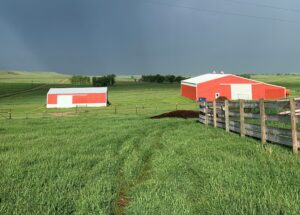
In the photo below (taken on 06-04-2020), the chicory (although difficult to see) is growing in and amongst grass, alfalfa, and clover, a prime, desirable setting for high chicory production. Research on growing cultivated chicory for wildlife food plots has shown the ideal plant mixture is chicory, alfalfa, and clover. We previously found that uncultivated (wild) chicory behaves much like its tame cousin in this scenario and, therefore, we were not surprised by the robust condition of the weed.
Not many chicory flowers were seen in early June because the plants were mostly in the pre-flowering growth stage. However, approximately three weeks later (on 06-23-2020), the plants reached the bolting stage and the flowers soon presented themselves. Although the leaves of the chicory plant taste bitter, the goats did eat the flowers. In the photos below (taken on 06-23-2020), there is clear evidence the goats removed the flowers, thus temporarily curtailing the seed production of the plant. The plants were still healthy and growing, however.
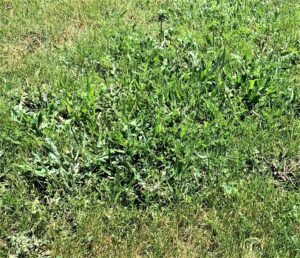
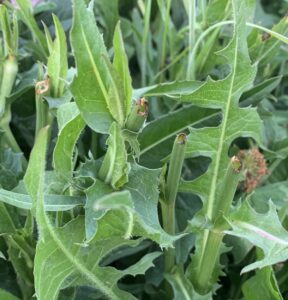
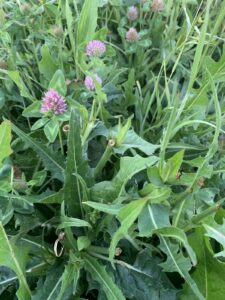
The goats were then rotated to graze a larger portion of the pasture and, within one month, the flowers reappeared in the one-acre plot. This is shown in the photos below taken on 07-24-2020. Our years of experience has been that the goats will never completely eliminate the chicory. They may control it in the short-term, but the existence of the weed plants is long-lasting. If the animals are forced to remain in the same area, there is a certain degree of temporary control. But once the animals are removed (as in rotated to another location), the chicory plant will quickly recover unless other IWM practices are initiated.
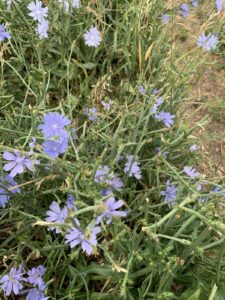
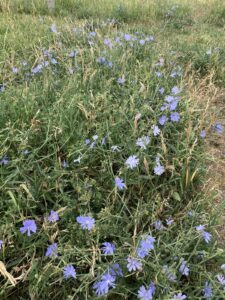
Observing that grazing had not met our long-term, sustainable goal of weed reduction/suppression or elimination in this small pasture test area, we decided to establish whether grazing, followed by chemical treatment, was effective. Therefore, two small areas within the one-acre test plot (each approximately 100 square feet in size) were treated with chemical on 07-30-2020. The chemical used was GrazonNext HL, applied at the equivalent of the maximum labeled rate of 2.1 pints per acre. As we will discuss later in the Chemical section, the ideal time to spray chicory is when it just begins to bolt but is still in the pre-flower stage. Since we sprayed in late July, we questioned whether the chemical application would be effective because the weather had turned hot and dry and most of the plant growth had seemed to slow. But we decided to go ahead and apply the chemical anyway. There are no restrictions for allowing animals to graze plants treated with GrazonNext once the chemical dries. Therefore, the goats were allowed back into the area to forage as they chose.
The following photos were taken 09-02-2020 in the same test area in the pasture. The goats had been returned to graze the area heavily. The results were noticeable; very few flowers remained in either the chemically treated or the untreated areas.
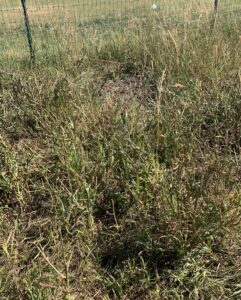
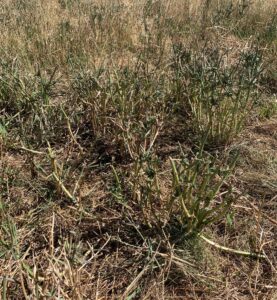
By this time, the hot and dry weather conditions we were experiencing caused much of the plant growth to slow or cease entirely; it was difficult to determine whether the nearly-dead appearance of the chicory plants was because of the chemical treatment or because the plants naturally had gone into a semi-dormant stage. Both types of plants looked the same. The test area was placed back into normal grazing rotation.
Even though only a few maturing flowers remained on the chicory plants, that didn’t indicate that the plants would not reproduce come spring. Our first-hand knowledge has taught us that just because the chicory plants appear to be “dead” or dried up (as appearing in the 09-02-2020 photos), the plant is still capable of spreading. Observations we made in April 2019 verified that point, as seen in the photos below. The plant’s structure above the soil surface appeared to be dried up. But a close-up examination of the soil surface at the base of the plant showed that chicory is truly a perennial and reproduces from the existing stems.
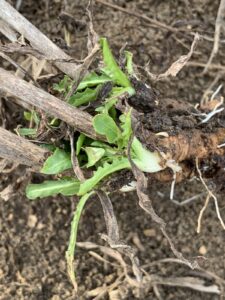
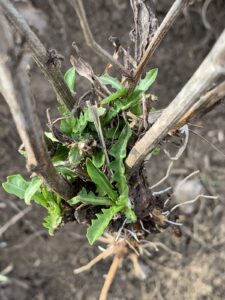
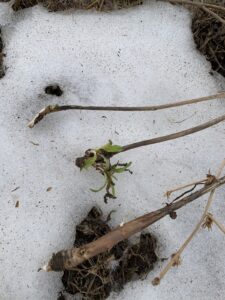
Autumn 2020 was warm and dry and, as of mid-December, the ground had yet to substantially freeze. From our research efforts, we again found that living chicory plants will have healthy roots with obviously living root tissue evident just below the soil surface, even well outside of the normal growing season, much like many perennials, particularly plants with tap roots as chicory has. The common trait of chicory is that the plants may actually have young, slow-growing green shoots at and just under the soil surface even in winter, as indicated by the photo taken on 02-01-2020.
Therefore, on 12-19-2020, we decided to evaluate the effectiveness of both grazing alone without chemicals and grazing with chemical application by examining the roots. The same test area documented in the photos above was the location for the evaluation. As shown by the photos below, taken on 12-19-2020, it would appear that no conclusion may be drawn from above-ground examinations comparing grazed-only versus grazed-treated plants. In each case, the portion of the plants above ground appeared to be either dormant or dead. In both cases, the grazing likely reduced the flowering portion of the plant, as the tops were “nipped” off on both the grazed-alone or those then treated with chemical. However, a significant difference could be found by probing the portion of the plant just below the soil surface, where the stem meets the upper portion of the tap root.
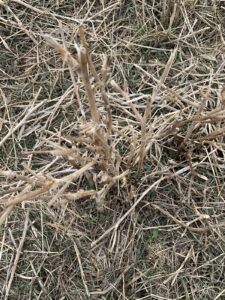
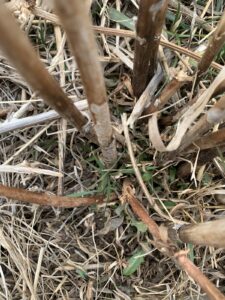
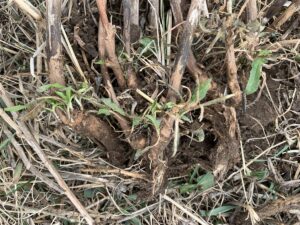
Our past observations have taught us that this is the location from which new growth emerges from older, existing, living plants. Clearly, the untreated plants had evidence of new growth.
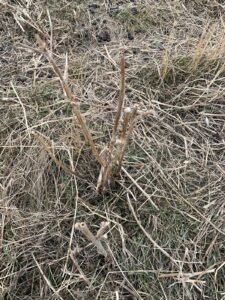
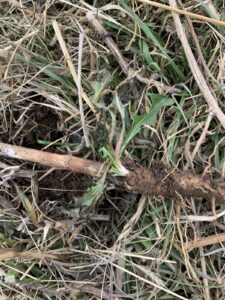
On the other hand, the treated plants showed no signs of new, living leaves or plant shoots, despite the fact that the lower portion of stems still had some green coloring on them.
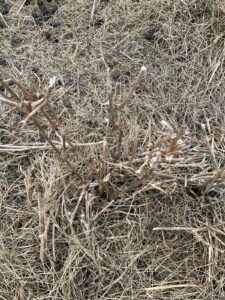
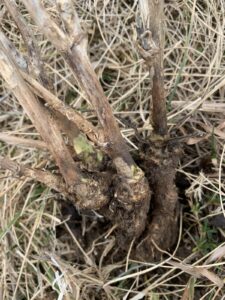
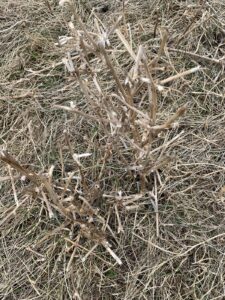
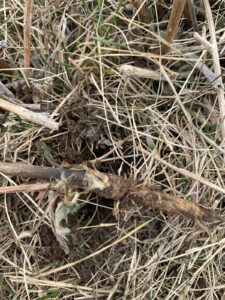
Another indicator of plant vitality is the difficulty we had in getting the plants out of the ground. Removing the grazed, untreated plants required us to dig deep to cut the roots, as they were noticeably pliable and alive. The grazed, treated plants could be removed from the ground much easier with a slight tug or pull on the stem. The plant stem separated from the root just under the surface and the roots either lacked vigor or were dead.
CONCLUSION: Will utilizing Biological/Grazing Control make a meaningful contribution to sustainable agriculture? In a broad sense, whether the farm/ranch operator is conventional or organic, grazing with animals is clearly an important component of a sustainable operation. It can supply the producer with profitable financial resources through livestock production for replacement breeding stock, food, and fiber. The proper utilization of livestock in an ag operation provides benefits to the land and soil health. In fact, in pasture and range country, a planned, rotational grazing program with animals regularly proves to be essential, and the recommendation to use animals in a sustainable agricultural operation cannot be overstated. Therefore, generally speaking, the IWM biological/grazing control fulfills the essential pillars of sustainability: productivity, stewardship, profitability, and quality of life.
However, if the primary reason for grazing animals (whether cattle, goats, or sheep) is specifically to control unwanted plants, and especially noxious, perennial weeds, our studies and results indicate there are limitations to using only the biological/grazing control. Grazing may provide some immediate, temporary results to control chicory. However, we found that unless the problematic area is subjected to continual, almost excessive grazing, the chicory has a likelihood of experiencing regrowth and will continue to spread.
By itself, and because of the reproductive nature of chicory (via seed and from existing plants, with growth stimulated by grazing or mowing), grazing falls short of a long-lasting solution. It is merely a stopgap control measure that (at least specific to our study of chicory) fails to sufficiently reduce or eliminate the weed problem. If the animals are removed for any length of time, the plants will undoubtedly rebound, re-flower, and reproduce. That, as we observed, could lead to the problem of spreading and infesting nearby fields and pastures. Loss of production, restricted marketability of crops, and reduced profit result. Therefore, we are reluctant to recommend grazing alone as a long-term sustainable IWM principle to either conventional or organic producers.
MECHANICAL/MOWING/HAND-PULLING
Mowing is one of the most common forms of mechanical IWM. The theory is if a weed is mowed a sufficient number of times, the energy-producing leaves and other plant structure is reduced and the plant eventually dies from lack of nutrients or by becoming weak and subject to pests and diseases. BUT… just as we found with grazing alone, mechanical IWM methods alone on chicory had limited success because of the specific growth and reproductive nature of the weed.
Some key points about chicory’s physiology should be considered by anyone when developing a weed control program for the weed. First, chicory is a member of the dandelion family (imagine it as the overgrown cousin of common dandelions and what efforts have to be taken to control that in your lawn). As with its smaller cousin, mowing results in new stems forming in a short amount of time. The flowers aren’t far behind. Second, chicory propagates from both seeds and existing plants. So, it is not enough to control the seed population; the existing living plant population needs to be reduced as well. Research states that a chicory plant will live for two years. However, research also points out that, given ideal growing conditions (moisture, stimulation, fertilization, etc.), the plants may live seven years or longer.
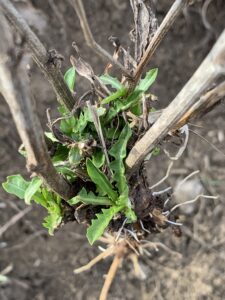
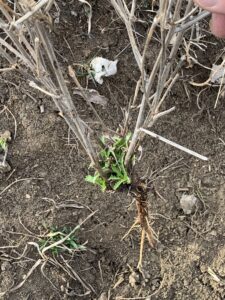
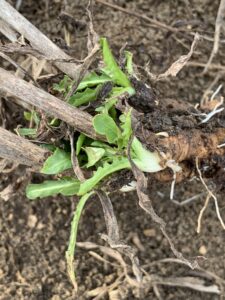
The plant is very adaptive to physical stimuli. A young plant will typically grow to 12” or 24” tall before it initially flowers. However, after repeated mowing or grazing, the plant develops flowers at lower and lower heights until the flowers actually form at ground level, still producing viable seeds.
Similar to grazing, mowing the plant may remove some (hopefully all) of the chicory’s flowers from the stem, preventing those flowers from producing seeds. However, just as we found with grazing, the plant flowers at a lower height, typically with more flowers than prior to mowing or grazing. Unlike grazing with animals who can consume plant matter at ground level, a mechanical mower is capable of only mowing so low to the ground.
Therefore, a mower eventually cannot get low enough to remove all the chicory’s reproduced flowers. As previously mentioned, the research shows that, like grazing, mowing also stimulates chicory to grow more prolifically. In each case, the removal of plant matter from a chicory plant only encourages the plant to grow stronger, contrary to the common theory that mowing will eventually harm or eliminate the plant. That simply has been our experience over the nearly 20 years of dealing with the plant on our farm.
Much of the specifics of our first year of research efforts applying mechanical IWM methods can be reviewed in our blog posts, and newsletters. The second year of testing either mowing or hand-pulling the weed did not produce any results different from that which we previously reported. To avoid repeating a great deal of information already published, our conclusion is there were no new lessons learned in our second year of research as to how to make applications of mechanical weed control on chicory effective without other IWM control measures, most specifically, chemicals.
To more conclusively demonstrate these findings, and to explain how we arrived at our conclusions, we continued to monitor the variable-height-mowed test plots utilized for our project. To review, this was a specific designated portion of a pasture, with four sections mowed separately at 3”, 6”, 9”, and 12” in height.
The lowest cutting obviously removed the greatest number of flowers but also substantially reduced the available forage for the cattle. Using a rotary mower chops the residue. The cattle weren’t enthusiastic about eating the cuttings since other living forage was available, especially younger, more tender plants that the taller material had covered up but was exposed by mowing. Although the 9” and 12” mowing heights left more forage, those heights also allowed new flowers to develop more quickly than the shorter cutting heights did. The 6” cutting showed some promising results and could be a good compromise between weed control and forage retention. However, while the flowers were controlled, the chicory population was not.
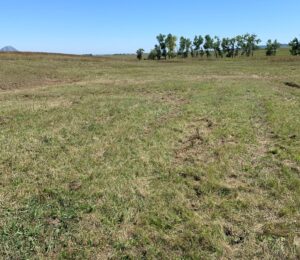
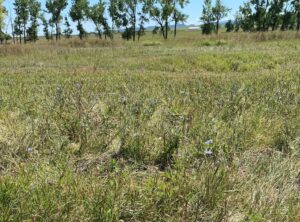
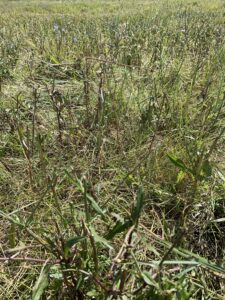
We had planned to graze these plots using goats, but due to unforeseen circumstances, we did not do so. Instead, a herd of cattle grazed the pasture, including the mowed plots, for several days up until 07-10-2020, when they were rotated to another pasture. The area was checked multiple times during that period, and it was apparent that the cattle had been consuming some of the chicory stems, very similar to what we had observed in the pastures where we had grazed goats. We had included cattle in the grazing program in 2019 as well, and as reported in previous reports and blog posts, we felt they also had some impact on the weed, although not as significant as the goats. Still, they were useful in our research.
Once the cattle were removed from the pasture that contained the mowed plots, the area was allowed to recover. Upon our examination on 07-18-2020, the chicory had some regrowth but, a week after the cattle were rotated, there were still no signs of flowers. We wondered if perhaps the combination of mowing and grazing may have had some advantageous results to control, reduce, or eliminate the weed. However, nine days later, on 07-27-2020, the plots were checked again. We again noted a significant rebound in the vigor of the chicory plants. As seen in the photos below, flowers had returned and new plant growth had erupted from the existing plants.
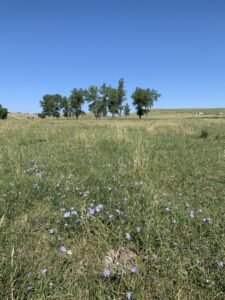
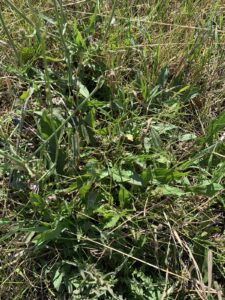
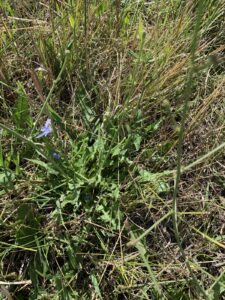
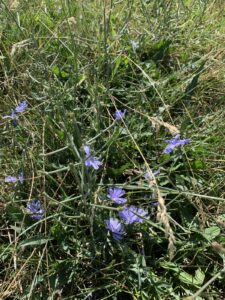
Coupled with what we have seen innumerable times over the years, and strengthened by our countless attempts to mechanically control chicory in our farm yard and other areas with constant mowing but with no results (as seen in the photos below taken on 05-25-2020), these further results convinced us that chemical IWM measures were necessary to prevent the problem in this pasture and others locations from becoming more serious that it already was.
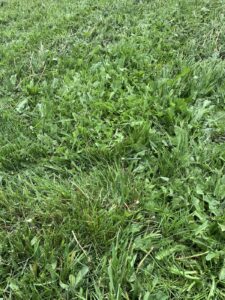
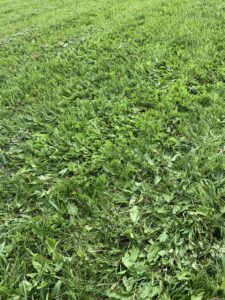
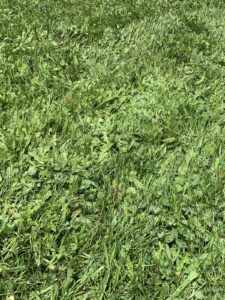
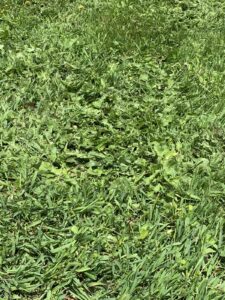
Therefore, on 07-27-2020, we chemically treated the mowed test plots. As with the goat-grazed test pasture addressed in the Biological/Grazed section above, the chemical used was GrazonNext HL, applied at the equivalent of the maximum labeled rate of 2.1 pints per acre.
The test plots were checked again on 09-02-2020 to observe if the chemical treatment had had any desired impact on the chicory. As seen from the photos below, the grasses and other forage had made a nice recovery, but the chicory plants appeared to be brown and dead.
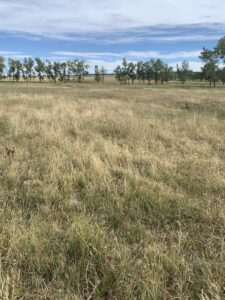
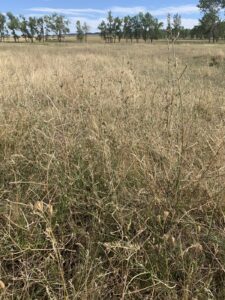
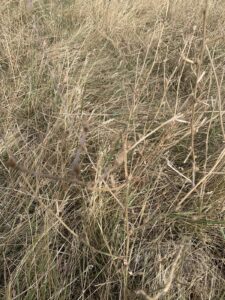
Ultimately, we found over the two years of our project that there is a great deal of similarity in results between IWM grazing control methods and IWM mowing control methods with regard to chicory. To finalize our evaluation of the effectiveness of using mechanical/mowing IWM to control chicory (both with and without chemicals), we thus referred back to our observations in the goat-grazed test plots for a basis to test the results in the mechanical/mowed plots. As reported in the Biological/Grazed section above, an assessment of IWM weed control methods on chicory can be made by examining the plant’s roots, even when completed late in the year, after a hard frost and when most all plants stop actively growing. There was a notable difference between the roots of the chemically-treated and untreated plants. Also, we knew that even in winter, as we had previously reported, chicory can slowly grow under the snow, as evidenced in the photo from 02-01-2020.

Therefore, we did a final check on the variable height mowed test plots on 01-22-2021 to see if there was any sign of new growth in mowed plants that had been treated and untreated. It appeared as though there were mixed results in the mowed test plots. We estimated that 50% of the chemically-treated chicory was eliminated and the other 50% had some signs of surviving. This shouldn’t have been a surprise, given the significant population of chicory in the area tested and the fact that the plots had not had chemical applied for some time. Achieving a 100% kill with one treatment is ideal but not always feasible, especially given the fact that the plots were not treated at the optimum application time (late spring when the chicory first starts to bolt).
Still, the chemical used for the treatment (GrazonNext HL) has both a pre- and post-emergence component. Therefore, despite the fact that half the treated plants had evidence of potential reproduction, we will evaluate the area at the beginning of the 2021 growing season to see if the pre-emergence chemical has been successful in sufficiently weakening the remaining living plants prior to us applying another round of chemical treatment.
Below are photos reflecting the results explained above.
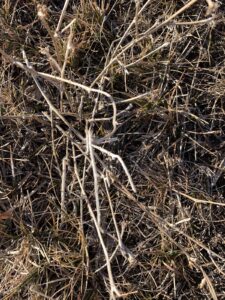
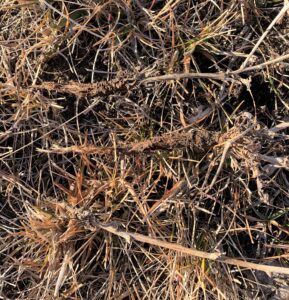
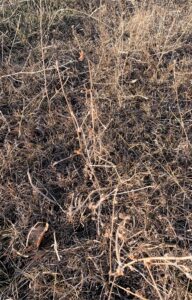
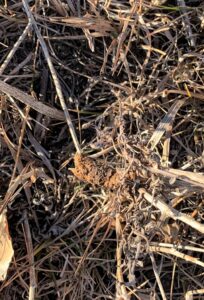
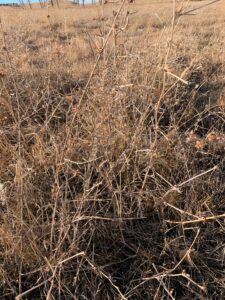
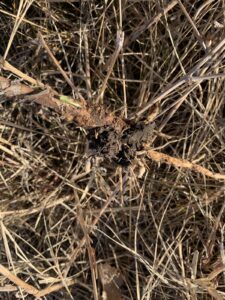
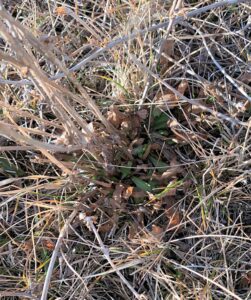
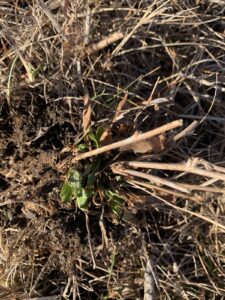
CONCLUSION: Will utilizing Mechanical/Mowing/Hand-Pulling Control make a meaningful contribution to sustainable agriculture? While mechanical methods are commonly recognized as being one of the most eco-friendly, organically-approved, and conventional means to control unwanted weeds, a number of issues need to be considered.
As with grazing, mechanical methods may perhaps be useful for some weed varieties, but not so with chicory because of its specific nature. For example, removing the seed heads from Mullen and some thistles in a timely fashion can result in a future reduction of plants. Not so with chicory.
Chicory has tap roots (capable of reaching deep into the ground). Thus, the chicory is able to remain strong and can recover in adverse (dry) weather conditions, even when mowed. However, the grasses that are also continuously mowed soon exhibit signs of distress, especially in dry conditions, because their shallow root system development is hampered by the constant removal of the above-ground plant matter, reducing the chance for grasses to develop deeper, thicker roots.
In short, we have seen very little long-term weed control success with mowing. Once mowed, it takes only a short time for the plant to regrow to the bolting stage, and to prevent the flowers’ seed from maturing, the chicory plant and everything around it must be mowed again, and again, and again. Yet even then, the chicory returns. In addition to the 05-25-2020 photos of our farm lawn seen above, these photos from the 2019 growing year are yet another clear reflection of how chicory grows, from pre-mowed (photo on left), mowed (two center photos), and nine days later (far right).
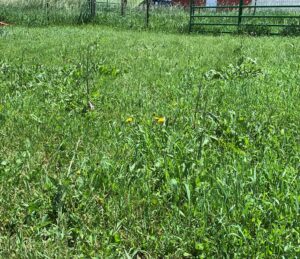
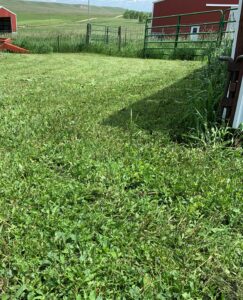
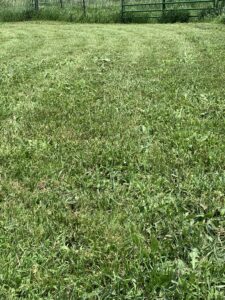
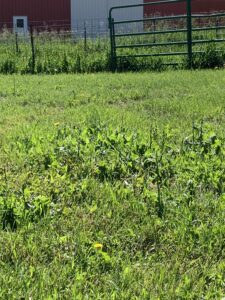
As mentioned, mowing chicory encourages it to regrow, and repeated mowing often results in more robust, not less, chicory population numbers. In order to effectively prevent the chicory from spreading to other parts of a field or beyond to other fields, the plants must be repeatedly mowed or pulled.
From a production and profitability aspect, if a field is to be used for hay, it may be possible to harvest an early crop by cutting the field for hay before the flowers develop. Most states’ noxious weed laws prohibit the spreading of weed seeds, not the non-seed-producing portion of the plant. Therefore, a crop may be cut early, processed, and sold. This is assuming the number of chicory plants is not too excessive, as we have routinely found that animals will refuse to eat the cured chicory plants due to their unpalatability. Many of our forage customers will understandably reject the hay if there is an excessive number of weedy plants remaining in an animal’s feed bunk. From a sustainability aspect, profit obviously suffers.
In our semi-arid environment, we have observed that once the first cutting is removed from the field, the chicory quickly regrows, re-bolts, and develops new flowers. This is often well before the other grasses and most alfalfa plants reach a sufficient height to produce a worthwhile second harvest. To mitigate additional weed infestation once the chicory reproduces flowers, the field must be mowed again to prevent the flowers and seeds from maturing. Therefore, along with the chicory, the grasses and alfalfa forage are prematurely cut and are unavailable for a second harvest. More concerning, repeated mowing of forage prevents the desirable plants’ structure and roots from fully recovering prior to being recut. The root structure is placed in danger of becoming weakened and the potential future yield of the field eventually suffers, further affecting productivity and profitability.
If the field is a pasture, animals alone will likely not sufficiently control the chicory, as we have covered in the Biological/Grazing section. Therefore, mowing may be considered an option to keeping the plant from producing matured seeds. However, mowing the chicory will also reduce the quantity of the other grasses and plants available to the animals. Thus, forage production drops and the length of grazing days will be reduced, all of which prevents the producer from realizing the full productivity potential and profitability of the pasture. None of that is sustainable.
Depending upon the magnitude of the chicory problem, hand-pulling may be considered in certain circumstances. For example, as seen in the photos below, we did hand-pull chicory from a field that was lightly infected with chicory in both 2019 and 2020, in order to allow us to market the hay from the field and to assure we did not spread chicory from our place. That approach is certainly “environmentally friendly” and, in this particular case, the chicory plant population was low enough to allow us to take the time and labor to pull it AND physically remove the plants from the field.
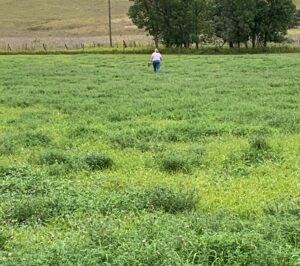
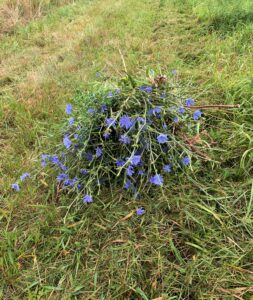
We should note that this particular field was only four acres in size. It would be neither profitable nor reasonably physically possible to repeatedly remove a heavy population of chicory from a large field. Realistically, pulling the weeds is excessively time consuming and physically demanding. Obviously, this can have a detrimental effect on a producer’s quality of life. If the chicory population and acreage is too great, this method is simply not feasible. Also, although we have employed this method on the small, four-acre field, the chicory is becoming more prolific and other measures will soon have to be taken.
All of this leads us to conclude that the IWM mechanical/mowing/hand-pulling method, when employed alone, is a poor candidate for a truly sustainable solution to chicory weed control.
CULTURAL
In the world of conservation, cultural IWM practices are a bit ambiguous at first. Admittedly, we still don’t have a great grasp on what it all entails and of all the various forms it takes. In a nutshell, cultural IWM is using non-chemical practices to control weeds, including crop rotation, seed selection, soil preparation, mulches, and other actions. Honestly, most producers have probably been doing cultural means of weed control for some time to improve their production and soil but really didn’t know it had a name associated with it.
One cultural method we used in 2019 was an attempt to plant a cover crop into two individual plots of a test field, one chemically treated and the other non-treated, to determine if the cover crops could choke out an infestation of chicory. This hayfield had been taken out of production and subjected to a rotational planting of oats (for three years) using minimum tillage and then returned to grass for forage. However, the resulting yields, new weed infestation, and soil conditions concerned us, and we decided to take the field out of production once again.
Although we did not till the field, we attempted to improve the soil by applying manure, by chemically controlling the weeds, and by allowing the existing grasses to maintain a living-root and soil microbial environment. We saw some improvement, but we were still disappointed and decided to basically restart from scratch.
For the cover crop trial, we opted to use a conventional drill since we didn’t have a no-till machine readily available. Thinking that many other producers might face the same limited application options, we choose to try the conventional drill we have in our machinery lineup. The wet field conditions in early spring of 2019 prevented us from starting the test before the plants had become tall and the plant canopy dense. By that time, we knew we would have an issue getting chemical to infiltrate into the canopy to a depth sufficient enough to reach many of the weeds, nor would the discs of the grain drill be able to cut deep enough to get the seeds to the soil. The plan was then to remove some of the top-most plant matter before applying chemical and planting. The chicory population did not make the field a good candidate for forage harvesting, so we decided to use a rotary mower to cut the plants. We mowed both test areas to a height of 8”, hoping that this would reduce the plant canopy but minimize the amount of plant residue spread across the soil.
The results were an absolute failure. Although the treated plants were affected by the chemical, the conventional drill still could not cut through the plant matter to get the cover crop seed to make contact with the soil. Hence, nothing germinated.
Our main lesson was this: Use the proper equipment or risk wasting money in an attempt to save money. Also, even though the hay was not at all desirable to use, the field should have been harvested rather than mowed, and the hay should have been either burned or, in a very controlled, preventative fashion, fed to livestock in a feeding area that could be chemically treated for weeds later.
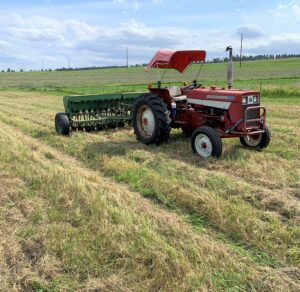
In 2020, we then planned to improve the same field using an alternative planting method: livestock. Instead of a cover crop, we had decided to inter-seed a variety of pasture grasses more suited to the soil conditions. We faced the same plant residue issues as in 2019. Because the residual plant matter that created the problem in 2019 still existed, and because we still did not want to deep till the field, we considered intensively grazing livestock to consume the existing plants. We felt that, once the plant material had been reduced to a sufficient degree, we could then broadcast the grass seed (testing both the conventional grain drill and a rotary seed spreader to evaluate which implement is best for this purpose). We would then continue to intensively graze the cattle to test the effectiveness of the cattle’s hoof action to incorporate the seed into the soil.
However, as is typical, livestock producers must often adjust their plans to coincide with neighbors who also graze their pastures at the same time, especially when breeding cows and bulls are involved. Consequently, due to grazing schedules and potential conflicts between the herds, the cattle within the test field were not able to graze to a satisfactory degree. When the “window of opportunity” to rotate the cattle back into the field opened for us, the weather had unfortunately changed to a hot and dry pattern and the planting conditions became far from ideal. Therefore, the project was suspended.
We plan to conduct this test in the spring of 2021 using our goats instead of the cattle to avoid struggles with the neighbor’s cattle. Unfortunately, we will obviously not have any research results available for this SARE project. Interested individuals may still read our blog, as we will post the results there.
Beginning in 2019, another cultural IWM method we tried involved evaluating the condition of the soils and measuring soil health to determine whether chicory infestations occurred in a particular type of soil, how the presence of chicory related to soil health, and whether there was any cultural change that could be made to the soil health itself to aid in reducing chicory. On 07-30-2019, we conducted a series of Haney Soil Tests in fields that were infested with chicory and some that were weed-free.
Tanse Herrmann from the USDA Natural Resource and Conservation Service office in Sturgis, SD, collected the soil tests in areas of our fields. Two of the tests were from weed infested and weed-free soils in the same pasture where the mechanical/grazing test plots detailed above were located. The infested and weed-free areas were within approximately 20 feet of each other to assure the soil structure was as similar as possible in both the weedy and weed-free area. The factor to be investigated was whether there was a difference in soils that have an overabundance of weeds compared to an area that is relatively weed-free. The presumption was that the weed-infested ground wouldn’t be as healthy overall and that, by improving the soil health, the desired plants could be increased and the chicory could be snuffed out. A follow-up question to be answered was whether there were any obvious cultural differences, measurable by a producer, that could be a predictor of whether a soil was susceptible to chicory infestations.
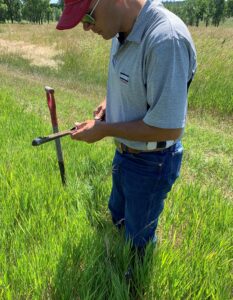
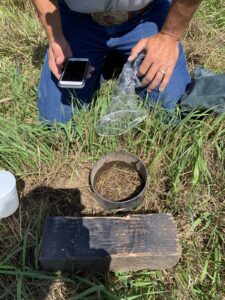
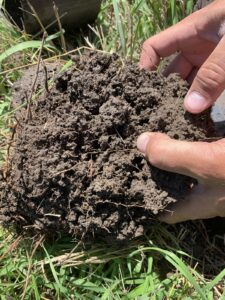
The results were interesting but did not provide any discernable difference between the weedy and weed-free environments. In fact, the test results were nearly identical. Across the spectrum of the lab’s report, the numbers did not reveal any significant clues that could lead us to propose any cultural changes to the soil chemistry that would reduce the health of the chicory population and still maintain the forages. On the contrary, and unfortunately, the soil conditions that chicory prefers were exactly that in which alfalfa and pasture grasses also thrive.
Comparing just a couple of notable readings:
- In the weed-infested area, the pH was 7.1, soil health calculation was 28.87, and the organic matter was 6.2. (Incidentally, a soil having a soil health reading of 28.87 and organic matter measure of 6.2 is really to be celebrated—those are great numbers!)
- The weed-free area had a pH of 7.1, soil health calculation was 27.35, and the organic matter was 6.9.
Among the soil qualities of good drainage, adequate fertility, and so forth that healthy pasture or hayfield plants desire, chicory prefers the same. Chemistry specific, chicory prefers a soil pH of 6.5 to 7.2. Alfalfa prefers 6.0 to 7.0. Most pasture grasses prefer a pH of 7.0. Therefore, while applying Sulphur or lime in any great quantities to change the soil’s pH could hamper the chicory growth, it would also have a counterproductive, detrimental effect on the forage plants.
A third Haney Soil Test was collected from the hayfield/oats field in which we had attempted to plant the cover crop and selective grass varieties. This test did produce some revealing numbers as to what happens when a soil is subjected to tillage, even minimum tillage. The numbers are also an indication of why getting a robust, high-producing forage crop in the field is posing to be a challenge. Although the figures aren’t disastrous, there is definitely room for improvement.
The third test’s results were as follows:
- The pH was 7.0 (very similar to the other field above). The soil health calculation was 8.17 (dramatically lower than the 28.87 and 27.35 tests from the pasture above). Finally, the organic matter was 4.0 (as compared to 6.2 and 6.9 above).
While 4.0 isn’t a terrible result—many good soils have organic matter levels of 4.0 – 6.0—it can be a clear indication of what occurs to a soil that is disturbed through tillage versus soils that are farmed in a no-till situation. The other interesting point is the 4.0 measure comes after significant quantities of manure had been applied. Manures can definitely aid in adding organic matter to a soil. But tillage can negatively affect the soil’s microorganisms and plant residues are not utilized to the fullest extent. The soil-building characteristics of an undisturbed native prairie or years-old grassland are hard to beat.
CONCLUSION: Will utilizing Cultural IWM Control make a meaningful contribution to sustainable agriculture? When properly applied (timing, methodology, suitable machinery, etc.), cultural methods are obvious options to consider, whether for an organic or conventional system. However, by themselves, they may not be the cure-all in certain circumstances, especially if the process is beginning with a heavy infestation of weeds. Just as with mowing or grazing, maintaining these methods may take the operation years into the future, if a producer has the weed problem under control. But, specifically speaking of chicory, if the infestation of weeds is severe to begin with, it may be prudent to take other steps first. Our experience has yet to prove to us that any non-chemical approach to a severe weed problem will, in a sustainable way, reduce the problem to a satisfactory degree.
CHEMICAL TRIALS
With the extremely valuable assistance of the South Dakota State University Extension Weed Science Coordinator (Mr. Paul Johnson) and Research Managers/Field Specialists (David Vos and Jill Alms), a comprehensive herbicide study was completed. As part of these trials, we examined options for both conventional and organic producers, which will be explained below. Both the herbicide and organic chemicals were one-time applications to each plot, all applied in the spring of 2019 on 06-28-2019.
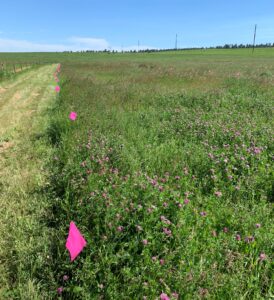
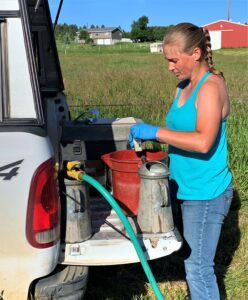
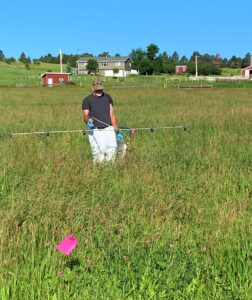
The 15 non-organic chemicals chosen for the project all proved to be effective against chicory, with one exception—Plateau—of the Imazamox family of chemicals. The herbicides were applied at different chemical concentrations, and in a mixture equivalent to a rate of 20 gallons of chemical mix per acre. As mentioned, all herbicide types showed results, except Plateau. We found that Plateau had an almost identical chemical structure and makeup as herbicides used in other research to remove unwanted weeds from cultivated chicory plots (Imazapic). Therefore, Plateau is actually SAFE to use on chicory.
The effectiveness of applying what could be termed “organic chemicals”—specifically 6% vinegar and pure alcohol/ethanol—to chicory-infested test plots proved less successful. These were also applied at the same rate of 20 gallons of chemical mix per acre. However, the difference between the herbicide and organic chemical mixes was the herbicide concentrates were dissolved in water according to label instructions. The organic compounds were not diluted but applied full-strength. Unfortunately, the application of vinegar and ethanol proved to have no controlling effect whatsoever on chicory.
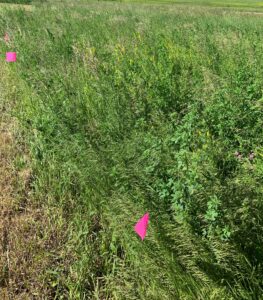
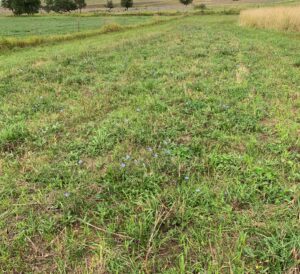
Before testing the “organic chemicals,” we had attempted to locate “horticulture vinegar,” which is far more concentrated than the 6% used in our project (typically 20% to 30% acetic acid/vinegar). However, we were unable to actually obtain any vinegar of that strength in our area. The one option we had was to order industrial strength cleaning vinegar through a local chemical company, also in the 30% concentration range.
We elected not to use any vinegar of that strength since, after doing more research into using the type of chemical of that strength, we realized there were clear hazards involved. First, it was recommended that special application equipment be purchased and used since 30% acid will render most chemical sprayers unusable. Second, it was also recommended to wear chemical-protective suits and breathing apparatuses. Since our project is targeted toward providing recommendations to the common producer without the need of purchasing specialized equipment or hiring professional staff, we felt it inappropriate to experiment with, nor recommend the use of, any type of chemical such as 30% industrial strength vinegar with its corrosive attributes. We point out a couple of additional cautionary notes regarding the use of vinegar later.
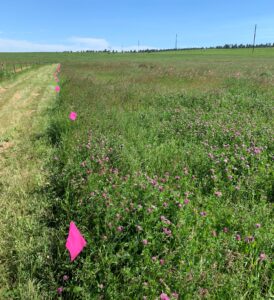
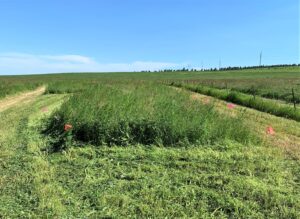
An evaluation of the results from the conventional chemical trials provided us with the information we needed to make definitive recommendations to our fellow producers. A key objective of the project was to find one or more herbicide applications that would offer options to control chicory and other unwanted weeds in fields with broadleaf forages (alfalfa) by controlling the chicory but not eliminating the alfalfa. As can be seen in the Herbicide Results Table linked below (reference the yellow highlighted entries), we have some optimism that, even though some chemicals are not labeled as such, they offered possibilities. Three herbicides in particular (Clarity, Cimarron Plus, and Garlon 4 Ultra) effectively suppressed the chicory but allowed the alfalfa and clover to recover to an adequate degree, not unscathed but sufficient enough to allow regrowth of the forages. Garlon 4 Plus had the least adverse effect on the alfalfa and clover.
NOTE OF CAUTION: These results were observed in older stands of alfalfa (such as ours, which are 20+ years old). We are reluctant to state what results we might have seen in newly-planted forages. We are NOT recommending that producers employ this method of weed control on large portions of their pastures or hayfields without first thoroughly testing the results themselves. If a farmer or rancher is curious about how it may work on their fields, we suggest testing a SMALL area, an acre or less, to avoid a highly regretful situation.
We had hoped to be more certain of the results from these three chemicals by the time we filed our final report. However, it took the full two years of this project for us to make certain that the alfalfa and clover seen recovering during the first year wasn’t just a matter of the forages temporarily surviving the first year only to die off the second year. When we saw that the forages had grown back even stronger the second year, we felt we should pursue this further. However, by that time, the timing for chemical applications had passed and we felt we would not realize true results. Therefore, we intend to continue this research in 2021, but we unfortunately will not be able to include the results in this report.
This table (Herbicide Results Table) lists the results from each of the 16 test plots (including the Control Plot). The chemicals are listed by name, the recommended (label) application rates per acre, the tested rates of application for purposes of our research, the results on controlling chicory, and the effect on forages (alfalfa and clover) in the plots.
It should also be noted that the 15 chemicals represented in our research incorporate many classes of chemicals. This is a key point to consider since many weeds are becoming resistant to certain herbicides that are used over and over in production settings. Having options to rotate to another class or category of herbicide can be critical to a long-term chemical approach to weed control.
Expanding on the organic tests, this research was conducted on six test plots. Social media has stories of people using vinegar (and even high-proof rum) to “kill” weeds and other unwanted vegetation in their yards and lawns. We applied undiluted household-strength cleaning vinegar (6% acetic acid) and 100% ethanol (equivalent to 200 proof alcohol) on chicory and other weeds in the six test plots at a rate of 20 gallons per acre.
An important note here; the stories on social media almost always state that the vinegar must be repeatedly applied to get results. Considering this option from a sustainability view, regularly putting 20 gallons of vinegar (or expensive alcohol) on an acre or more of ground without successfully controlling any weeds is simply not feasible, profitable, or reasonable.
The University of Maryland Extension conducted a study comparing vinegar and other non-chemical alternatives to glyphosate. The report, updated in 2017, can be viewed by following this link: https://extension.umd.edu/sites/extension.umd.edu/files/_docs/programs/ipmnet/Vinegar-AnAlternativeToGlyphosate-UMD-Smith-Fiola-and-Gill.pdf. In that report, the authors indicated that to reach an effective application rate of vinegar to kill plants that have grown beyond the 1-2 leaf stage (within two weeks of germination), the applied rate may need to be increased from 20 to 100 gallons per acre and multiple passes may be necessary. Even then, weeds with tap roots, such as chicory, can still survive, as non-chemical alternatives routinely do not kill the plant’s roots; they only affect the top portions of the plants.
Cost is also a factor, especially on large areas. In the University of Maryland report, a 2008 study is noted from the University of Massachusetts Transportation Center in which it was found that using glyphosate to control weeds along roadways cost approximately $20 per mile. Alternative "organic" materials cost from $360 to $2400 per mile.
Another unpleasant fact about vinegar is that if it reaches the soil where there are earthworms present, it dehydrates the earthworms, which kills them. Therefore, if a producer is striving toward having healthy soils, removing the earthworms is certainly not a recommended way to help work toward that goal.
Many reports indicate that repeated use of vinegar alone does not change the chemical makeup of the soil, nor adversely affects soil microbes since vinegar (chemical compound CH3COOH) quickly breaks down when it is absorbed by the soil. However, it is not noted whether other ingredients such as Epsom salts (not a true salt but actually an inorganic compound with a chemical composition of MgSO4-7H2O) or common table salt (NaCl), when added to vinegar to have a more noticeable weed-control effect, change the soil environment over time. More research should probably be done on this.
CONCLUSION: Will utilizing Chemical IWM Control make a meaningful contribution to sustainable agriculture? Ideally, from what many believe to be a “sustainable” approach for the environment, being able to have an effective IWM program absent of chemicals is a desirable goal. However, unless a producer is fortunate to have an entirely weed-free environment without a threat of infestation from outside sources, removing chemical IWM methods from their toolbox could have adversely consequential results.
This may lead some to believe we have a bias towards using chemicals and that we are opposed to organic production. But as noted several times in the previous sections, we tried applying non-chemical IWM approaches to our specific situation for not only the two years of our SARE Project, but years of operation before, without any significant suppression or elimination of the chicory problem. To risk losing production and profitability (i.e., no longer being sustainable), we had no other alternative but to use chemicals as the one method to get the chicory problem under control. We should emphasize again that this is true of our growing conditions, environment, moisture totals, and other factors for our part of the country. A producer living where moisture is more abundant and where tillage and/or row crop agriculture are workable options could perhaps resort to more reliance on mechanical, biological, or cultural IWM controls only. Every producer needs to adapt methods to their circumstances.
Every year, new techniques (non-chemical) are being developed, tried, and tested. Perhaps in the future, a method will become available to us. But, in the meantime, we believe that the proper use of chemicals, with close attention to the labeled instructions and conditions of usage, can be beneficial without causing undue harm to the environment or our natural resources. Thus, to sum up the answer to the above question, yes, we can recommend that chemical IWM can make a meaningful contribution.
PREVENTATIVE MEASURES
As we have noted in other documentation, the primary preventative step we take on our farm is refusing to market any chicory-infested hay harvested on our farm. In the event we feed this hay to our own livestock, we feed the bulk of the weed infested hay during the winter when the animals spend more time in their barns and smaller holding pastures. There, we can control and effectively deal with weed re-infestation if it happens. Similarly, the manure from the animals is composted to aid in reducing viable seed as well. Even so, we only apply infested manure on fields where we are not reluctant to use chemical control.
Another action we take is, in cases of harvesting a field with a heavy population of chicory, we will clean machinery before moving to a non-infested field. In short, we have put forth our best efforts to assure that we don’t intentionally allow chicory to spread beyond our property.
Yet another step we take is simply being meticulous in monitoring the weed problem on our entire farm. This is testament to the fact of our belief that scouting is a crucial component of IWM. While we spent quite an effort describing our chemical trials, leading some to conclude that we are firm supporters of herbicides (the answer there being, yes, when absolutely necessary with no other feasible option), the one issue we didn’t mention is that there are large portions of our farm that haven’t had chemicals of any sort applied to them for at least 20 years. Unfortunately, as time goes on, and as the chicory problem is becoming more widespread in our region, we continue to experience an encroachment of weed infestations from areas outside of our control. Thus, we find ourselves resorting to other control methods to keep noxious weeds from intruding further onto our property, threatening to erase the weed-free areas we have previously preserved.
CONCLUSION: Will utilizing Preventative IWM Control make a meaningful contribution to sustainable agriculture? Clearly, yes. The essence of preventative IWM methods is doing what is reasonable, necessary, and responsible to keep weed problems contained in such a manner as to be able to assure the applications of other IWM practices are as successful and long-lasting as possible. Preventative measures should not be viewed as a sole replacement for other IWM methods but a means of “insurance” for the producer to reap the benefits of the efforts for as long as possible.
Project Outcomes
FINAL THOUGHTS OF OUR MULTIFACETED IWM PROGRAM
As mentioned earlier in the outreach and education section, determining the depth of what is meant by controlling chicory, in itself, can be termed a success. From speaking with ag professionals and producers over these past two years, we've come to realize that there is a lack of studies (especially verifiable studies) on specifically addressing the chicory infestation problem. Our conversations indicate that the invasive nature of the plant seems to be demanding more attention than in recent years. The means of how the weed spreads is now better known to us, and more and more ag producers and professionals are becoming aware of the detrimental impact that allowing the plant to grow uncontrollably is having on the environment. It was exciting for us to share what we are learning with the people we have spoken to and to see the anticipation from producers and professionals as we gathered more and more data through the research.
In 2019, we focused on using one IWM technique on each particular test plot or area. Then, knowing how the five IWM techniques work independently, and having a better idea of the strength and weaknesses of each, in 2020 we merged them together to approach weed control from a comprehensive, five-pronged, multi-practice approach. This is typically what most producers would do on a regular basis on their operation.
Our being able to answer the question of how each IWM control approach will contribute to sustainable agriculture clarified our focus and mapped the direction we will move forward with in the future. Other producers looking for ideas and recommendations can consider those answers and decide for themselves what may or may not work for their unique situation.
Some other final thoughts for our fellow farmers and ranchers to consider:
- IWM is not a one-method approach. It is most effective when applied as a holistic program of all IWM principles.
- Before starting a new weed management program, read, research, and study ideas that seem reasonable for your operation. What works in one part of the country may be completely unrealistic in another.
- What are the goals you want to achieve? As we said earlier, “It’s difficult to develop a map to get to where one WANTS TO GO if it isn’t known where one WANTS TO BE.”
- Define level of control to be achieved. Do you want a quick stopgap measure, a suppression of the weed to keep its presence in check, a reduction of the problem, or an all-out elimination of the weed? Each level is attainable with IWM.
- Share ideas, successes, and failures. Each presents an opportunity for someone to learn.
WHERE COULD THE RESEARCH GO FROM HERE?
As seen by the length of this final report, our project was quite broad, intentionally encompassing many aspects of IWM all at once being testing independently and simultaneously. Weed control is never ending as is the research. As we progressed, we made note of a number of future research projects that could be done, again by the common farmer or rancher.
Whether a producer chooses to apply for a SARE grant or decides to try some innovative ideas on their own, here is list of a few thoughts to get the exploratory juices flowing. We are actually going to do some of these ourselves in the future but, unlike the multi-faceted project we just completed, we will take on one or two items at a time, keeping the projects smaller and simpler, more focused, and costing less.
- The chemical trials revealed that three chemicals showed promise on controlling chicory in older stands of alfalfa, with Garlon 4 Plus exhibiting the least negative effect on the forage. Additional trials should be conducted to further verify that using Garlon 4 Plus is a good option to remove chicory from alfalfa and clover fields. We are going to continue this research ourselves.
- We were not able to fully evaluate the feasibility of using livestock to incorporate grass and/or forage seeds into existing fields and pastures of a semi-arid climate (such as ours) to improve production. We are going to move forward with this concept. We feel that livestock could take the place of a no-till planting apparatus. Once an innovative idea, this practice is becoming more common, but we haven’t seen any formal research on this topic, not that such research hasn’t been done, but we just haven’t found it.
- The use of vinegar and other non-chemical alternatives to control weeds has been popular on social media. We pointed out some unfortunate side effects in that applying vinegar to soil often kills earthworms and can have some potentially harmful consequences to the applicator. We wondered what changes to soil chemistry would be found if vinegar (even the 6% cleaning variety) were repeatedly applied, as recommended on the internet. Research that we have read indicates that there is no change to pH or other soil makeup, as the acetic acid compounds break down quickly. Frankly, we are skeptical, especially if Epsom or table salts are added to the mix (as is also recommended) to make the vinegar applications more effective. A small project could be to test a small plot over time, taking an initial Haney Soil Test and then another after repeated vinegar treatments are applied to the point the plants are “killed” (actually fully dehydrated) to measure the pH and soil health. The results would be interesting, to say the least.
- Despite using mechanical means, grazing, and cultural practices to reduce the infestation of chicory (all without chemicals other than vinegar and ethanol, which failed to show promising options for organic producers), much more work could be done to study adapting innovative organically-acceptable practices in arid regions such as ours, especially without resorting to conventional tillage or “farming” techniques used by organic producers in regions that receive more rainfall. An ag operation doesn’t necessarily need to be organically certified to utilize organic practices. Anytime IWM can be successfully accomplished with less dependence on chemicals, there are advantages gained, especially given the current public feeling toward the use of pesticides. We admit we don’t know what these “innovative organically acceptable practices” look like. But that doesn’t mean someone, somewhere isn’t trying something that may work for us, too.
These are just a few thoughts for future research. If a producer has an idea, research it and consider it. They may even have a future SARE project.
